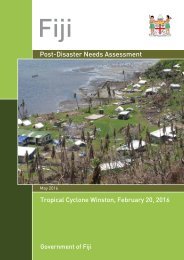Vanuatu_PDNA_Web
Vanuatu_PDNA_Web
Vanuatu_PDNA_Web
You also want an ePaper? Increase the reach of your titles
YUMPU automatically turns print PDFs into web optimized ePapers that Google loves.
2 Tropical Cyclone Pam, March 2015<br />
1.1 Disaster Risk Profile of <strong>Vanuatu</strong><br />
<strong>Vanuatu</strong> is considered to be the world’s most vulnerable country to natural hazards. This is due<br />
to a combination of <strong>Vanuatu</strong>’s exposure to both geophysical and hydrometeorological hazards,<br />
and its limited financial and technical capacity to prepare for and respond to the associated risks.<br />
Geographically, <strong>Vanuatu</strong> is located in the Pacific Ring of Fire and at the center of the Pacific cyclone<br />
belt. This results in a relatively high frequency of volcanic eruptions, cyclones, earthquakes,<br />
tsunamis, storm surges, coastal and river flooding, and landslides. In addition, the country suffers<br />
from extreme events associated with climate variability, including sea-level and temperature<br />
extremes and droughts (UNU-EHS 2014).<br />
Consequently, <strong>Vanuatu</strong> is expected to incur, on average, US$48 million per year in losses due to<br />
earthquakes and tropical cyclones. In the next 50 years, <strong>Vanuatu</strong> has a 50% chance of experiencing a<br />
loss exceeding US$330 million, and a 10% chance of experiencing a loss exceeding US$540 million. 4<br />
1.2 Socioeconomic Context of <strong>Vanuatu</strong><br />
<strong>Vanuatu</strong> is<br />
expected to incur,<br />
on average,<br />
US$48 million per<br />
year in losses due<br />
to earthquakes<br />
and tropical<br />
cyclones.<br />
<strong>Vanuatu</strong> is an archipelago of 83 volcanic islands (65 of them inhabited) covering a total area of<br />
about 12,200km 2 , of which approximately a third is land. <strong>Vanuatu</strong>’s population of approximately<br />
253,000 people is almost evenly distributed among the six administrative provinces: Malampa,<br />
Penama, Sanma, Shefa, Tafea, and Torba. An estimated three-quarters of households engage in<br />
primarily subsistence livelihoods in rural areas.<br />
<strong>Vanuatu</strong> faces many of the geographic and structural challenges common to other countries in the<br />
Pacific. Remoteness, in conjunction with small size and internal dispersion, imposes additional costs<br />
of trade and transportation, and means that domestic markets tend to be too small for industries to<br />
benefit from economies of scale. The same factors also push up the cost and complexity of providing<br />
public services and fulfilling the basic functions of government.<br />
Despite these challenges, <strong>Vanuatu</strong> has taken advantage of opportunities to support growth and<br />
private sector development in recent years. It has become one of the faster-growing economies in<br />
the Pacific region, with growth mainly driven by tourism, construction, and aid inflows. However,<br />
<strong>Vanuatu</strong> remains vulnerable to external shocks (due in part to its narrow economic base) and natural<br />
disasters. Moreover, the cost of basic infrastructure services remains relatively high, which adversely<br />
affects the environment for doing business and reduces connectivity. While extreme hardship is<br />
very rare in <strong>Vanuatu</strong>, the challenge of ensuring that the benefits of growth are distributed broadly<br />
across the population is ongoing. Gross domestic product (GDP) per capita is estimated at around<br />
US$3,300, which is below the average for Pacific Island countries.<br />
Because of the high cost structure, low tax revenues, and limited space for additional borrowing,<br />
<strong>Vanuatu</strong> has found it difficult to provide substantial funding for basic public services and infrastructure.<br />
However, the government has recently embarked on a new infrastructure development program<br />
financed with a mix of development grants and loans. The government’s focus on infrastructure<br />
investments and better access to basic services should help relax some of the binding constraints to<br />
economic growth, while also directly benefitting the population.<br />
4<br />
The calculation is based on modelling from PCRAFI (2011).



